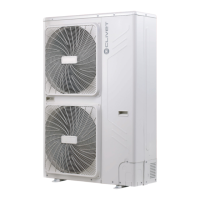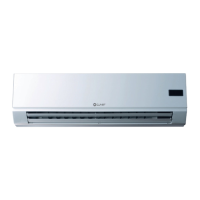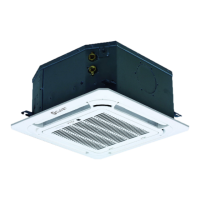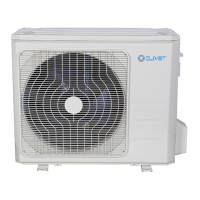53
Maintenance
9 MAINTENANCE
It is good practice to periodically clean both the internal
and external parts of the appliance. This guarantees its
proper operation and durability.
Carry out periodic maintenance of the appliance in
accordance with the regulations in force.
Maintenance must be carried out by qualified technical
personnel.
Improper maintenance or service can cause electric
shock, fire or water leakage.
f
ATTENTION ELECTRIC DANGER
Before cleaning or maintenance, always switch
o the air conditioner and disconnect it from
the power supply.
This unit contains R410A fluorinated gas. It is forbidden to
release it into the environment.
The GWP (Global warming potential) over a temporal
period of 100 years is equal to 2090 units
As it does not contain chlorine atoms, this mixture does
not damage the ozone layer.
For equipment that contains fluorinated greenhouse
gases in quantities of 5 tons of CO or more but in any
case less than 50 tons, a test must be carried out to
check for the leaking of refrigerant once every 12 months.
If a leak detection system is installed, the test must be
carried out every 24 months.
For equipment that contains fluorinated greenhouse
gases in quantities of 50 tons of CO2 or more but in any
case less than 500 tons, a test must be carried out to
check for the leaking of refrigerant once every 6 months.
If a leak detection system is installed, the test must be
carried out every 12 months.
l
WARNING
Do not check or repair the unit yourself.
Contact skilled professionals to carry out
checks and repairs. Do not use substances
such as petrol, thinners or chemical dust cloths
to clean the appliance. This could remove the
top layer of paint. If the unit is dirty, soak a cloth
in diluted neutral detergent, wring it out to dry
it and then clean the appliance with it. Lastly,
dry it with a dry cloth.
a
CAUTION
If a fuse has blown, replace it with one with the
same characteristics. Using electrical cables or
copper wires can cause the unit to malfunction
or start a fire.
a
CAUTION
Do not insert fingers, sticks or other objects
into the air inlet or outlet. Do not remove the
fan grille. The fan can cause personal injury
when running at high speed.
It is extremely dangerous to check the unit
when the fan is turning.
Always switch o the main switch before
starting any maintenance work.
Check the unit’s supporting structure and
base for any damage after a long downtime.
The unit could fall and cause personal injury.
Discharge the pressure before disassembly.
Below are some modes that do not represent malfunctions
The outdoor unit makes a hissing noise . It can be caused:
– by expansion due to heat or by contraction due to
cooling of the heat exchanger, depending on the
temperature variations;
– at the beginning or at the end of the defrosting
process, the 4-way valve may emit a sound similar to
that emitted by a flow of water which will be amplified
after a few minutes;
– by the flow of refrigerant or the discharge of drainage
water;
– by operation of the drain pump (accessories on
request).
– by a change in inverter frequency operation
The heat exchanger of the outdoor unit discharges mist or
water. It can be caused:
– by defrosting of the outdoor unit.
Mist coming out of the outdoor unit.
– The heat produced by defrosting the outdoor unit
evaporates the humidity on the coil.
The power indicator of the indoor unit flashes. It can be
caused:
– by restarting after an abnormal shutdown;
– by mode conflict;
– by stopping of the fan to avoid spreading cold air.
Automatic starting or stopping. It can be caused:
– by activation of the timer.
The system is not working. It can be caused:
– by the lack of power;
– by closing of the manual power switch;
– by the presence of a blown fuse;
– by the presence of a time schedule;
– The air conditioner does not switch on immediately
after pressing the ON/OFF button on the remote
control;

